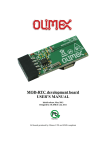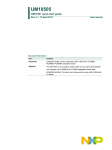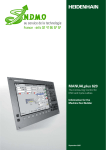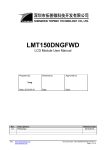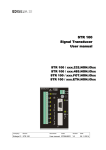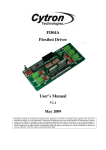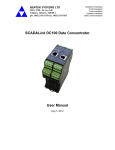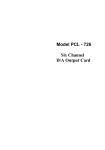Download UM10763 - NXP Semiconductors
Transcript
UM10763 PCA8536 and PCF8536 as LCD and backlight driver Rev. 1 — 11 November 2013 User manual Document information Info Content Keywords PCA8536, PCF8536, LCD, backlight, PWM Abstract NXP has designed the LCD driver family PCx8536 that integrates a PWM controller and up to 6 PWM channels that can be used for LED backlighting, as well as for LED button illumination. The PCx8536 family allows programming the LCD frame frequency and the PWM frequency more than 50 Hz apart to prevent any display flickering. UM10763 NXP Semiconductors PCA8536 and PCF8536 as LCD and backlight driver Revision history Rev Date Description v.1 20131111 new user manual, first revision Contact information For more information, please visit: http://www.nxp.com For sales office addresses, please send an email to: [email protected] UM10763 User manual All information provided in this document is subject to legal disclaimers. Rev. 1 — 11 November 2013 © NXP B.V. 2013. All rights reserved. 2 of 11 UM10763 NXP Semiconductors PCA8536 and PCF8536 as LCD and backlight driver 1. LCD illumination The Liquid Crystal materials emit no light on their own. Therefore the Liquid Crystal Displays (LCDs) need a form of illumination to produce a visible image. In the “reflective” mode, the ambient light is used to illuminate the display. The illumination is achieved by combining a reflector with the rear polarizer. LCD mirror Fig 1. Reflective mode LCD In the “transmissive” mode, a special light source is used at the back of the glass, known as a backlight. In combination with a transparent rear polarizer it does not reflect the ambient light. LCD Fig 2. Transmissive mode LCD The reflective LCDs work best in an outdoor or well-lit environment; transmissive LCDs work best in low-light conditions, with the backlight continuously on. Transmissive LCDs guarantee much better optical performance but require a backlight, a circuitry to drive the backlight, and this implies higher power consumption. UM10763 User manual All information provided in this document is subject to legal disclaimers. Rev. 1 — 11 November 2013 © NXP B.V. 2013. All rights reserved. 3 of 11 UM10763 NXP Semiconductors PCA8536 and PCF8536 as LCD and backlight driver There are also “transflective” LCDs that are a mixture of the reflective and transmissive types, with the rear polarizer having partial reflectivity. They are combined with backlight for use in all types of lighting conditions. The backlight can be left off where there is sufficient light, which saves power, and with the backlight on it can provide a bright display in darker environments. LCD Fig 3. Transflective mode LCD 2. LED backlighting Today, most LCD displays are designed with LEDs as backlight instead of the traditional cold cathode fluorescent lamp (CCFL) backlight, since they allow a brighter and sharper image while reducing the power consumption. The LEDs could be white for a black and white display or RGB for a chromatic effect. Fig 4. UM10763 User manual LED backlighting All information provided in this document is subject to legal disclaimers. Rev. 1 — 11 November 2013 © NXP B.V. 2013. All rights reserved. 4 of 11 UM10763 NXP Semiconductors PCA8536 and PCF8536 as LCD and backlight driver The LEDs could be placed in a row at one or more edges of the screen or could be placed in an array covering a large area of the display. A light diffuser is typically used to spread the light evenly across the whole display. Figure 5 shows a display fitted together with the LED backlight in a plastic frame. Fig 5. LCD with backlight LEDs in a plastic frame The most common way to control the brightness of an LED is to switch the current, flowing through the LED, on and off by applying a Pulse Width Modulation (PWM) signal, rather than driving the LED with a variable continuous current. As long as the PWM switching frequency is higher than the human flicker fusion threshold, the backlight shows no flicker. In addition, PWM does not cause a color shift, which is the main drawback when using a variable continuous current to dim an LED. UM10763 User manual All information provided in this document is subject to legal disclaimers. Rev. 1 — 11 November 2013 © NXP B.V. 2013. All rights reserved. 5 of 11 UM10763 NXP Semiconductors PCA8536 and PCF8536 as LCD and backlight driver VDD PWM Fig 6. PWM controller driving the LED 3. Display flickering The LCD driving principle also creates flicking. Although the LCD and PWM frequency are both set higher than the human flicker fusion threshold, the combination of these two frequencies generates an intermodulation product or beat frequency. This beat frequency is the sum and difference of the PWM and LCD frequencies. If this beat frequency is below the human flicker fusion threshold, a visible flickering can still occur. This happens when the difference between the LCD frame frequency and the LED PWM frame frequency is too small. As a consequence, maximum care must be taken when selecting independent LCD and LED drivers for the LCD module design and detailed testing and evaluation is required to avoid any flickering in the application. The problem can be even more complicated when the clock source for the LED and LCD are not the same. The separate devices will have different responses to temperature and different variations over production life, meaning that even if flicker is carefully avoided during the design phase, it may appear later on during production. 4. PCA8536 and PCF8536 as LCD and backlight driver avoiding flickering To solve these difficulties, NXP has designed the LCD driver family PCx8536 that integrates a PWM controller and up to 6 PWM channels that can be used for LED backlighting, as well as for LED button illumination. UM10763 User manual All information provided in this document is subject to legal disclaimers. Rev. 1 — 11 November 2013 © NXP B.V. 2013. All rights reserved. 6 of 11 UM10763 NXP Semiconductors PCA8536 and PCF8536 as LCD and backlight driver PWM Controller: - For LED backlighting - For LED button lighting Fig 7. Application with PCA8536 or PCF8536 The LCD frame frequency and the PWM frequency are derived from the same clock source and can be programmed independently; it will be enough to program the two frequencies more than 50 Hz apart to prevent any display flickering across the operating temperature range and production spread. Intensity of visible flickering Flickering is most visible when fPWM and ffr(LCD) are within 10 Hz of each other In general, the higher the PWM frame frequency, the less flickering will be visible Flickering is also visible at multiples of the fundamental frequency; however, the visibility is lower Flickering will not be visible when fPWM and ffr(LCD) are more than 50 Hz apart f1 2f1 This will repeat for 3f1, 4f1, etc. f0 013aaa449 Fig 8. Flicker avoidance for LED backlighting UM10763 User manual All information provided in this document is subject to legal disclaimers. Rev. 1 — 11 November 2013 © NXP B.V. 2013. All rights reserved. 7 of 11 UM10763 NXP Semiconductors PCA8536 and PCF8536 as LCD and backlight driver To reduce the BOM as well as testing and evaluation efforts, NXP suggests using the PCx8536 as LCD driver and LED controller. 5. References UM10763 User manual [1] PCA8536 — Automotive LCD driver for low multiplex rates including a 6 channel PWM generator [2] PCF8536 — Universal LCD driver for low multiplex rates including a 6 channel PWM generator All information provided in this document is subject to legal disclaimers. Rev. 1 — 11 November 2013 © NXP B.V. 2013. All rights reserved. 8 of 11 UM10763 NXP Semiconductors PCA8536 and PCF8536 as LCD and backlight driver 6. Legal information 6.1 Definitions Draft — The document is a draft version only. The content is still under internal review and subject to formal approval, which may result in modifications or additions. NXP Semiconductors does not give any representations or warranties as to the accuracy or completeness of information included herein and shall have no liability for the consequences of use of such information. 6.2 Disclaimers Limited warranty and liability — Information in this document is believed to be accurate and reliable. However, NXP Semiconductors does not give any representations or warranties, expressed or implied, as to the accuracy or completeness of such information and shall have no liability for the consequences of use of such information. NXP Semiconductors takes no responsibility for the content in this document if provided by an information source outside of NXP Semiconductors. In no event shall NXP Semiconductors be liable for any indirect, incidental, punitive, special or consequential damages (including - without limitation - lost profits, lost savings, business interruption, costs related to the removal or replacement of any products or rework charges) whether or not such damages are based on tort (including negligence), warranty, breach of contract or any other legal theory. Notwithstanding any damages that customer might incur for any reason whatsoever, NXP Semiconductors’ aggregate and cumulative liability towards customer for the products described herein shall be limited in accordance with the Terms and conditions of commercial sale of NXP Semiconductors. Right to make changes — NXP Semiconductors reserves the right to make changes to information published in this document, including without limitation specifications and product descriptions, at any time and without notice. This document supersedes and replaces all information supplied prior to the publication hereof. Suitability for use — NXP Semiconductors products are not designed, authorized or warranted to be suitable for use in life support, life-critical or safety-critical systems or equipment, nor in applications where failure or malfunction of an NXP Semiconductors product can reasonably be expected to result in personal injury, death or severe property or environmental damage. NXP Semiconductors and its suppliers accept no liability for inclusion and/or use of NXP Semiconductors products in such equipment or applications and therefore such inclusion and/or use is at the customer’s own risk. Applications — Applications that are described herein for any of these products are for illustrative purposes only. NXP Semiconductors makes no representation or warranty that such applications will be suitable for the specified use without further testing or modification. UM10763 User manual Customers are responsible for the design and operation of their applications and products using NXP Semiconductors products, and NXP Semiconductors accepts no liability for any assistance with applications or customer product design. It is customer’s sole responsibility to determine whether the NXP Semiconductors product is suitable and fit for the customer’s applications and products planned, as well as for the planned application and use of customer’s third party customer(s). Customers should provide appropriate design and operating safeguards to minimize the risks associated with their applications and products. NXP Semiconductors does not accept any liability related to any default, damage, costs or problem which is based on any weakness or default in the customer’s applications or products, or the application or use by customer’s third party customer(s). Customer is responsible for doing all necessary testing for the customer’s applications and products using NXP Semiconductors products in order to avoid a default of the applications and the products or of the application or use by customer’s third party customer(s). NXP does not accept any liability in this respect. Export control — This document as well as the item(s) described herein may be subject to export control regulations. Export might require a prior authorization from competent authorities. Evaluation products — This product is provided on an “as is” and “with all faults” basis for evaluation purposes only. NXP Semiconductors, its affiliates and their suppliers expressly disclaim all warranties, whether express, implied or statutory, including but not limited to the implied warranties of non-infringement, merchantability and fitness for a particular purpose. The entire risk as to the quality, or arising out of the use or performance, of this product remains with customer. In no event shall NXP Semiconductors, its affiliates or their suppliers be liable to customer for any special, indirect, consequential, punitive or incidental damages (including without limitation damages for loss of business, business interruption, loss of use, loss of data or information, and the like) arising out the use of or inability to use the product, whether or not based on tort (including negligence), strict liability, breach of contract, breach of warranty or any other theory, even if advised of the possibility of such damages. Notwithstanding any damages that customer might incur for any reason whatsoever (including without limitation, all damages referenced above and all direct or general damages), the entire liability of NXP Semiconductors, its affiliates and their suppliers and customer’s exclusive remedy for all of the foregoing shall be limited to actual damages incurred by customer based on reasonable reliance up to the greater of the amount actually paid by customer for the product or five dollars (US$5.00). The foregoing limitations, exclusions and disclaimers shall apply to the maximum extent permitted by applicable law, even if any remedy fails of its essential purpose. 6.3 Trademarks Notice: All referenced brands, product names, service names and trademarks are the property of their respective owners. All information provided in this document is subject to legal disclaimers. Rev. 1 — 11 November 2013 © NXP B.V. 2013. All rights reserved. 9 of 11 UM10763 NXP Semiconductors PCA8536 and PCF8536 as LCD and backlight driver 7. Figures Fig 1. Fig 2. Fig 3. Fig 4. Fig 5. Fig 6. Fig 7. Fig 8. Reflective mode LCD . . . . . . . . . . . . . . . . . . . . . . .3 Transmissive mode LCD . . . . . . . . . . . . . . . . . . . .3 Transflective mode LCD. . . . . . . . . . . . . . . . . . . . .4 LED backlighting . . . . . . . . . . . . . . . . . . . . . . . . . .4 LCD with backlight LEDs in a plastic frame . . . . . .5 PWM controller driving the LED. . . . . . . . . . . . . . .6 Application with PCA8536 or PCF8536 . . . . . . . . .7 Flicker avoidance for LED backlighting . . . . . . . . .7 UM10763 User manual All information provided in this document is subject to legal disclaimers. Rev. 1 — 11 November 2013 © NXP B.V. 2013. All rights reserved. 10 of 11 UM10763 NXP Semiconductors PCA8536 and PCF8536 as LCD and backlight driver 8. Contents 1 2 3 4 5 6 6.1 6.2 6.3 7 8 LCD illumination . . . . . . . . . . . . . . . . . . . . . . . . 3 LED backlighting . . . . . . . . . . . . . . . . . . . . . . . . 4 Display flickering . . . . . . . . . . . . . . . . . . . . . . . . 6 PCA8536 and PCF8536 as LCD and backlight driver avoiding flickering . . . . . . . . . . . . . . . . . 6 References . . . . . . . . . . . . . . . . . . . . . . . . . . . . . 8 Legal information. . . . . . . . . . . . . . . . . . . . . . . . 9 Definitions . . . . . . . . . . . . . . . . . . . . . . . . . . . . . 9 Disclaimers . . . . . . . . . . . . . . . . . . . . . . . . . . . . 9 Trademarks. . . . . . . . . . . . . . . . . . . . . . . . . . . . 9 Figures . . . . . . . . . . . . . . . . . . . . . . . . . . . . . . . 10 Contents . . . . . . . . . . . . . . . . . . . . . . . . . . . . . . 11 Please be aware that important notices concerning this document and the product(s) described herein, have been included in section ‘Legal information’. © NXP B.V. 2013. All rights reserved. For more information, please visit: http://www.nxp.com For sales office addresses, please send an email to: [email protected] Date of release: 11 November 2013 Document identifier: UM10763











